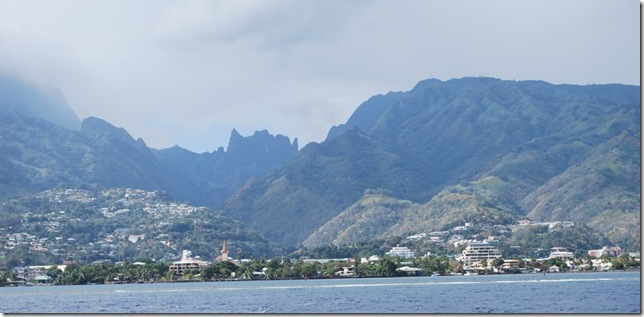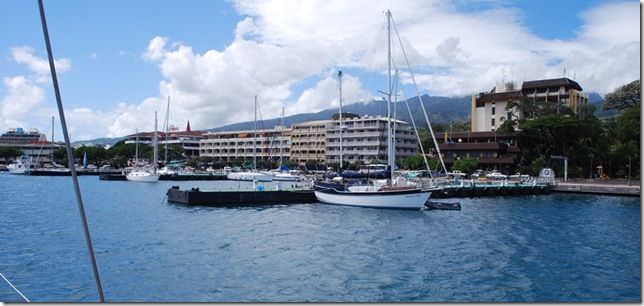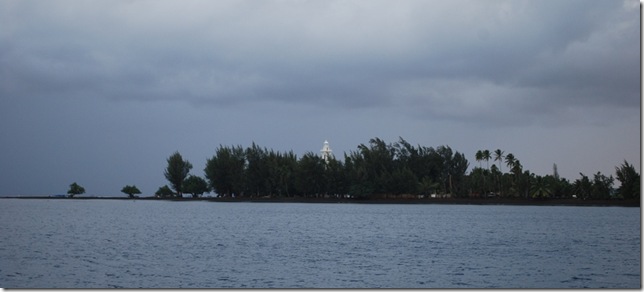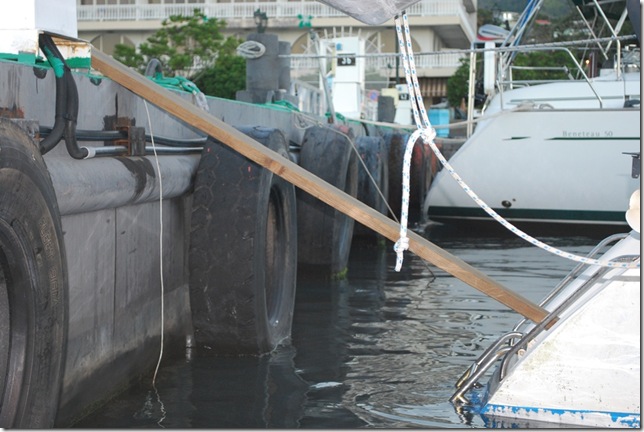First we’ll answer some cultural questions of the greatest significance. Is there a McDonald’s in Papeete, Tahiti, French Polynesia? Yes. Does it serve a "Royale with cheese"? Yes. Are the french fries served with mayonnaise? Yes, the mayonnaise pump is next to the ketchup pump.
We made it to the island of Tahiti Sunday around midnight and instead of trying to negotiate the pass and enter the port and capital city of Papeete, we elected to anchor and get some sleep. We dropped anchor in Matavai Bay, southwest of Venus Point, with the Venus Point lighthouse sweeping its light above us. Venus Point is where Captain Cook came to observe the transit (solar eclipse) of Venus in 1769 for the Royal Society, which had sponsored his voyage (Cook recognized the Royal Society by naming this group the Society Islands).
The calm anchorage awoke slowly, but early. We could see and hear cars driving on the busy road by the beach. Several people on the beach were working with an outrigger 100 yards or so off the shore to catch fish in a large net, and a morning soccer game was going strong in the small field near the lighthouse. The healthy barking of the pet dogs here sounded noticeably different than the barks of the mongrel atoll dogs, and though there were are some roosters crowing, it was nothing like the morning din in a Marquesas village.
The mountain peaks were visible beneath the clouds on the way to the pass and we were able to see the diadem, a Tahiti mountain feature that resembles its namesake. Entry formalities weren’t bad, and we even got a form that will allow us to by diesel duty-free when we leave from Bora Bora. Yachts have traditionally moored "Tahitian-style" here in Papeete with their stern tied to bollards at the quay along Pomare Blvd (King Pomare was the first monarch to convert to Christianity) and an anchor set off of the bow. We had our chance to try this for the first time, and it’s definitely a challenge. We had a strong wind at our stern, which is not a bad place for the wind, but we only learned after tying up that there are now bow lines tied to moorings and we didn’t need to anchor. The only casualty was a helm/AIS VHF antenna that is mounted at deck level and was snapped off when it was caught in a dockline. Hopefully, our anchor won’t be tangled up in all of the stuff on the bottom here.
 Diadem above the suburbs of Tahiti
Diadem above the suburbs of Tahiti
Although tying up along Pomare Blvd used to be a tradition, most yachts now go to the large Marina Taina, about 10 miles away on the northern edge of the west coast. We were headed there as it’s free to anchor out, but we’re waiting for a package from Fed Ex with replacement laptops to clear customs and are hoping that one more night here will allow us to leave a for Moorea a bit quicker. In case you’re wondering, there are two reasons we didn’t shop here for laptops. The first is that since we’re a yacht in transit and aren’t importing the good into Tahiti permanently, we’re able to avoid paying import and VAT/sales taxes. The second reason is that the computers here run the French version of Windows.
 We tied up at the second dock, at the edge of Pomare Blvd.
We tied up at the second dock, at the edge of Pomare Blvd.
Papeete itself is a moderate-sized city. It’s not especially clean or beautiful, but there’s plenty of shopping. Prices in general are high, but you can get almost anything you want here. The grocery prices are definitely cheaper than in the more remote islands, but the restaurants are more expensive. The architecture is pretty plain and the people don’t seem as happy or relaxed. After time in such quiet, beautiful places my preference is definitely to leave the big city as soon as we can and head back to more scenic and less populated places.
Our Brazilian friends on Matajusi came over for a visit yesterday evening and Silvio had a good story from their Panama-Galapagos crossing. 300 miles offshore, he spotted a speedboat, which seemed like an odd thing. It made more sense when he noticed the next day that what he thought was a shark behind the boat was actually a fishing buoy, and there was quite a lot of very heavy offshore fishing line that had become caught on the boat’s underbody and was being towed behind him. He was getting ready to jump in and try to free it when he looked down and saw a massive shark swimming behind the boat! Apparently it had made its way along the long stretch of line, eating the fish that were hanging from the hooks embedded in it and was now at the end of the line, so to speak. Ultimately, the shark left and Silvio was able to jump in and clear the line.
In a twist of good luck, I was able to buy the same model of VHF antenna at a local marine store at a reasonable price. Carrying the 8-foot antenna tube while riding the folding bike back along the edge of Pomare Blvd. (Papeete’s non-bike-friendly main thoroughfare) and through round-abouts was a bit of an adventure. As I neared the dock, a French guy on a bicycle behind me pedaled past and had a few things to say about my riding with the antenna that I didn’t entirely comprehend. I’m sure he was complimenting my agility resourcefulness in avoiding a long walk or large cab fare.



